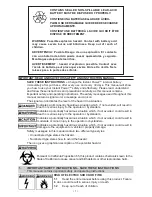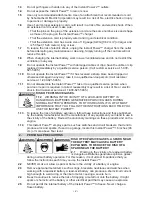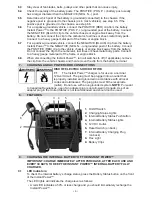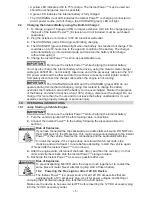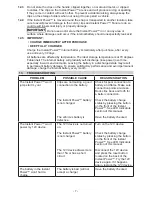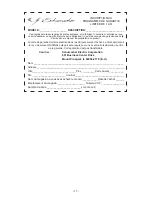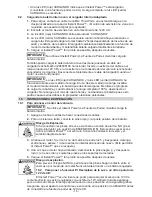
• 3 •
To prevent sparking, NEVER allow clips to touch together or contact the same piece of metal.
2.6
Consider having someone close enough by to come to your aid when you work near a
2.7
lead-acid battery.
Have plenty of fresh water and soap nearby in case battery acid contacts your skin,
2.8
clothing or eyes.
Wear complete eye and body protection, including safety goggles and protective
2.9
clothing. Avoid touching your eyes while working near the battery.
If battery acid contacts your skin or clothing, immediately wash the area with soap and
2.10
water. If acid enters your eye, immediately flood the eye with cold running water for at
least 10 minutes and get medical attention right away.
If battery acid is accidentally swallowed, drink milk, the whites of eggs or water. DO NOT
2.11
induce vomiting. Seek medical attention immediately.
PREPARING TO USE THE INSTANT POWER
3.
™
RISK OF CONTACT WITH BATTERY ACID. BATTERY ACID IS
A HIGHLY CORROSIVE SULFURIC ACID.
Be sure the area around the battery is well ventilated while
3.1
the jump starter is being used.
Clean the battery terminals before using the jump starter.
3.2
During cleaning, keep airborne corrosion from coming into contact
with your eyes, nose and mouth. Use baking soda and water to neutralize the battery
acid and help eliminate airborne corrosion. Do not touch your eyes, nose or mouth.
Add distilled water to each cell until the battery acid reaches the level specified by the
3.3
battery manufacturer. Do not overfill. For a battery without removable cell caps, such as
valve regulated lead acid batteries (VRLA), carefully follow the manufacturer’s instructions.
Read, understand and follow all instructions for the Instant Power™, battery, vehicle
3.4
and any equipment used near the battery and Instant Power™. Study all of the battery
manufacturer’s specific precautions while charging and recommended rates of charge.
Determine the voltage of the battery by referring to the vehicle owner’s manual and
3.5
make sure that the output voltage of the jump starter is correct.
Make sure that the Instant Power™ cable clips make tight connections.
3.6
INSTANT POWER™ LOCATION
4.
RISK OF EXPLOSION AND CONTACT WITH
BATTERY ACID.
Locate the Instant Power™ as far away from
4.1
the battery as the DC cables permit.
Never place the Instant Power™ directly
4.2
above the battery being jumped; gases from the
battery will corrode and damage the Instant Power™.
Do not operate the Instant Power™ in a closed-in area or restrict the ventilation in any way.
4.3
DC CONNECTION PRECAUTIONS
5.
Connect and disconnect the DC output clips only after setting all of the Instant Power™
5.1
switches to the “off” position (if applicable) Never allow the clips to touch each other.
Attach the clips to the battery and chassis, as indicated in section 6.
5.2
FOLLOW THESE STEPS WHEN CONNECTING TO A BATTERY
6.
A SPARK NEAR THE BATTERY MAY CAUSE A
BATTERY EXPLOSION. TO REDUCE THE RISK
OF A SPARK NEAR THE BATTERY:
Attach the output cables to the battery and
6.1
chassis as indicated below. Never allow the output
clips to touch each other.
Position the DC cables to reduce the risk of damage by the hood, door and moving or
6.2
hot engine parts. NOTE: If it is necessary to close the hood during the jump starting
process, ensure that the hood does not touch the metal part of the battery clips or cut
the insulation of the cables.


